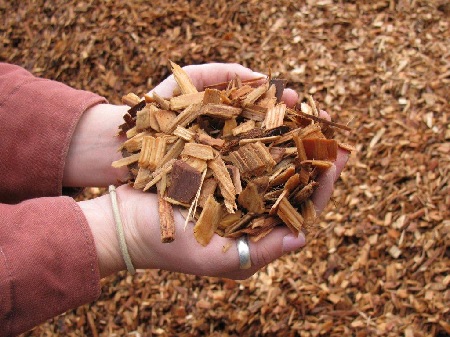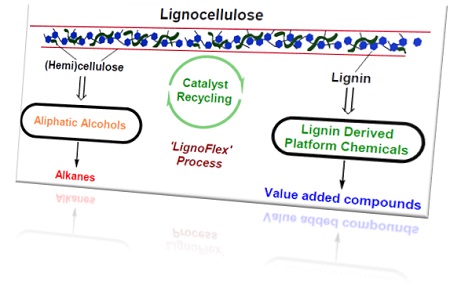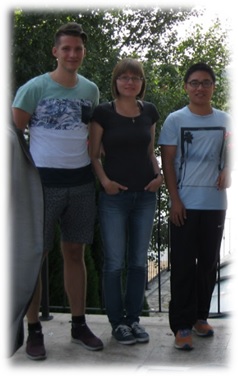New method makes the most of biomass
In a sustainable society, we need to use renewable sources for the manufacture of carbon-based products rather than fossil fuels. Lignocellulosic biomass is available in abundance, but refining this into useful compounds is tricky. Usually only a fraction is converted into high value molecules. Now, University of Groningen chemists have developed a catalytic method that completely breaks down lignocellulose and converts the resulting molecules into a variety of useful building blocks.
Lignocellulose is the most abundant source of carbon-based molecules in the world. It is made of a combination of three different biopolymers: cellulose, hemicellulose and lignin. These polymers can be used as building blocks in the chemical industry or to produce biofuels, but they first have to be broken down into smaller molecules.

Difficult
The snag is that conventional pulping methods focus on extracting high quality cellulose for further use, for example in bioethanol production. The lignin part is left behind, but modified in structure. This makes it extremely difficult to further utilize, so it is usually burned. But now, a team of University of Groningen scientists led by Associate Professor of Catalysis for Green and Sustainable Chemistry Katalin Barta have found a way to break lignocellulose down into aromatics and aliphatic alcohols. In addition, they have devised new pathways to use the end products of this process to produce valuable bio-based products.
They started with a recently developed method to extract the lignin from lignocellulose, which combines catalytic processing and pulping. This usually takes place in an organic solvent, but in this method the leftover solid cellulose ends up mixed with the catalyst. ‘This makes it very difficult to recover the cellulose and re-use the catalyst’, explains Barta.

She decided to tackle the problem, and used a copper catalyst to break down the lignocellulose in two steps. ‘We tried our very simple two-step idea, and to our delight it worked very well. We got a full conversion of the lignocellulose.’ The copper catalyst produced aromatic compounds from the lignin and a mixture of alcohols from the cellulose. An added bonus was that the catalyst could be fully recycled.
Building blocks
And it got even better: depending on the source of the biomass, the aromatics would be mainly one particular molecule or a mixture of just a few, instead of the complex mixtures that are the usual outcome of lignin breakdown. ‘This made it possible to isolate a single aromatic compound from lignin. We could then devise pathways to obtain a whole range of interesting products, including amines, which are important building blocks in the chemical industry but had not yet been obtained from lignin.’

The group could then convert the alcohol mixtures from the cellulose into fuel-range alkanes. In a paper that was published in the inaugural issue of the journal Nature Catalysis in January, Barta and her colleagues describe the new catalytic method for the full conversion of lignocellulose, and the subsequent steps to produce valuable chemicals.
‘The first author, Zhuohua Sun, who will defend his PhD thesis later this year, persistently drove this work forward, despite challenges along the way, especially regarding the downstream processing. I was also very happy to see a true group effort and intensive collaboration between authors from different backgrounds. Everyone focused on the central question of how to derive the most value from lignocellulose.’
Reference: Zhuohua Sun, Giovanni Bottari, Anastasiia Afanasenko, Marc C. A. Stuart, Peter J. Deuss, Bálint Fridrich & Katalin Barta: Complete lignocellulose conversion with integrated catalyst recycling yielding valuable aromatics and fuels. Nature Catalysis doi:10.1038/s41929-017-0007-z
| Last modified: | 25 January 2018 12.36 p.m. |
More news
-
21 November 2024
Dutch Research Agenda funding for research to improve climate policy
Michele Cucuzzella and Ming Cao are partners in the research programme ‘Behavioural Insights for Climate Policy’
-
13 November 2024
Can we live on our planet without destroying it?
How much land, water, and other resources does our lifestyle require? And how can we adapt this lifestyle to stay within the limits of what the Earth can give?
-
13 November 2024
Emergentie-onderzoek in de kosmologie ontvangt NWA-ORC-subsidie
Emergentie in de kosmologie - Het doel van het onderzoek is oa te begrijpen hoe ruimte, tijd, zwaartekracht en het universum uit bijna niets lijken te ontstaan. Meer informatie hierover in het nieuwsbericht.

